You Wait 30 Years….
How Jaguar torpedoed its own dreams
Reproduced with permission of The Road Rat magazine (July 2021)
Jaguar XJR15 vs Jaguar XJ220
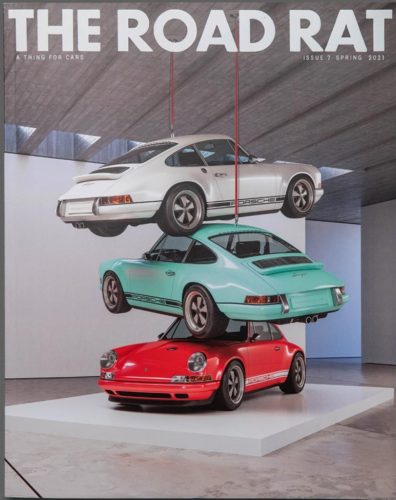
The Road Rat Issue 7 Spring 2021
On 20 December 1989, Sir John Egan, chairman of Jaguar, had some news to share: Project XJ220, the fastest Big Cat yet, was to go into limited production. The company’s first supercar since the D-type of the 1950s was to be built by Tom Walkinshaw.
Only Walkinshaw had a little secret he’d yet to share with Egan.
THE SITUATION WAS AN EXTRAORDINARY ONE for a car company to find itself in. Through the 1980s, Jaguar had morphed from being the largest loss-making brand in the crumbling British Leyland edifice to a profitable enterprise so transformed that Ford thought it worth paying $2.5 billion to acquire.
But just three years after that 1990 deal, Jaguar would be suing its own customers to buy a car that played a key part in convincing Ford to dig so deep: the XJ220.
It was one of the most talked-about models the company had ever produced, yet Jaguar was issuing writs against wealthy depositors who were trying to back out of buying one. The depositors responded by threatening to counter-sue, the argument being put forward by one of them – Michael Pearson, now the 4th Viscount Cowdray of Midhurst, West Sussex – that Jaguar had undermined the value of its £470,000 XJ220 supercar by producing a second supercar, the XJR-15.
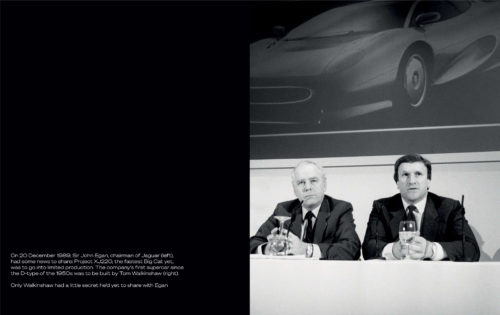
The Road Rat Issue 7
Spring 2021 Pages 162-3
On paper, the two machines had certain similarities. At a time when supercars were morphing into hypercars – think Ferrari F40 and Porsche 959 – both offered around 500 bhp, both claimed to crack 200 mph, both were born from racing technology and both were produced for Jaguar by the mercurial motorsport entrepreneur Tom Walkinshaw, a key player in this tale.
But the XJR-15 had a couple of crucial elements in its favour: it was derived from an actual race-winning car using the latest in Formula One carbon-fibre tub technology, as pioneered by McLaren through the preceding decade. Perhaps more importantly, it had a Jaguar V12 engine that the show-stopping XJ220 concept from 1988 promised but never delivered. If you were serious about the pedigree of your half-million-pound supercar, the XJR-15 looked by far the better investment.
So how on Earth did Jaguar, at that point a manufacturer of cars more elegant than sporting, come to offer a wider supercar range than Lamborghini in the early 1990s?
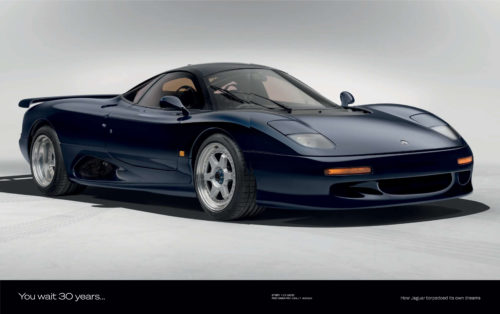
The Road Rat Issue 7
Spring 2021 Pages 164-5
The story is forged in Jaguar’s escape from the stifling clutches of state-owned behemoth British Leyland in 1984, when it was privatised by one of Margaret Thatcher’s favourite industrialists, John Egan. The culture fostered by Egan as he successfully led Jaguar through the 1980s empowered engineers who, under BL, had been starved of cash in favour of appeasing the manufacturing unions. Employee pride in the brand rose along with sales and profits, and in 1988 – arguably the company’s finest single year since founder Sir William Lyons stepped down in 1972– Jaguar achieved what few had thought possible when it split from BL: record sales and a run of profits. It won Le Mans in the XJR-9, a car that would form the basis of the XJR-15. It also unveiled the XJ220 concept, a show-stopper that so impressed the world, Jaguar’s director of public affairs at the time, David Boole, estimated that in just one month it generated £10 million-worth of free publicity in terms of column inches.
“I am a straightforward capitalist businessman,” Egan boasted soon after selling Jaguar to Ford in 1990. With his cherubic face, tightly curled hair and relative youth (barely into his 40s), Egan didn’t look as though he possessed the mettle needed to wrestle unions, reverse archaic working practices and hone Jaguar into a fighting force capable of taking on Mercedes and BMW. But his experience in shaping spares division Unipart into becoming BL’s sole competitive entity had toughened him up, and given him the confidence to believe he could turn the company around. ‘The salesman in me saw a remarkable opportunity,’ he recalled in his 2015 book, Saving Jaguar.
In the brief few years before Ford installed its own stifling corporate system, creativity flourished in a way we’d compare to a start-up now, argues Keith Helfet, designer of the XJ220. “There was an environment at Jaguar that contributed to the creation of that car – one that probably couldn’t happen today,” he says.
But there was also a cultural hangover from the BL days that meant management was distrusted, a key factor in the creation of the XJ220. And then there was Walkinshaw, a character of such persuasive power that even an industry titan like Egan couldn’t contain him. ‘I discovered to my cost what a formidable negotiator he was,’ Egan recalled. ‘I therefore only discussed money with him just after he had got out of a race car, exhausted from a stint at the wheel. He was canny even then.’
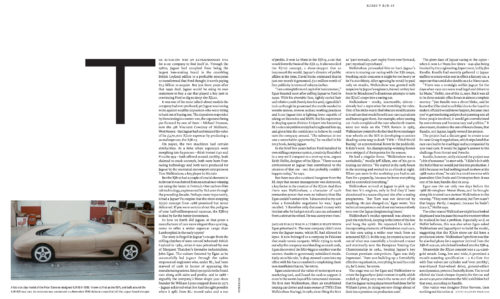
The Road Rat Issue 7
Spring 2021 Pages 166-7
JAGUAR REALLY WAS IN A TERRIBLE STATE WHEN Egan privatised it. The new company didn’t even own the Jaguar name, which BL had allowed to lapse. It now belonged to a company in Pakistan that made tennis racquets. While trying to work out why the company was bleeding so much cash, Egan discovered the fifth-biggest supplier was the caterer, thanks to generously subsidised meals. Early on in his role, ‘a shop steward came into my office with his bacon sandwich complaining there was insufficient bacon,’ he wrote.
Egan understood the value of motorsport as a marketing tool, and found the cash to support it even in the worst days of his turnaround mission. He first met Walkinshaw, then an established touring car driver and team owner of TWR (Tom Walkinshaw Racing), in 1981, describing the Scot as ‘part tornado, part rugby front-row forward, part mystical leprechaun’.
Walkinshaw persuaded him to back Jaguar’s return to touring car racing with the XJS coupe, brushing aside concerns it might be too heavy or its V12 too thirsty. After agreeing he would be paid only on results, Walkinshaw was greeted with suspicion by Jaguar’s engineers, burned as they had been by Broadspeed’s disastrous attempts to turn the XJ12C coupe into a racing car.
Walkinshaw – stocky, inscrutable, driven – already had a reputation for stretching the rules. One of his tricks was to find obscure modifications to road cars that would benefit race-car equivalents and homologate them. For example, when touring car rivals complained the rear wheelarch inserts were too wide on the TWR Rovers in 1983, Walkinshaw pointed to the fact that Rover ran larger rear wheels on the SDI in developing countries (leading some wag to daub ‘TWR = Third World Racing’ on a promotional Rover in the paddock). It didn’t work – his championship-winning Rovers were stripped of their points for the season.
He had a singular focus. “Walkinshaw was a workaholic,” recalls Jeff Allam, one of his go-to touring car drivers. “He started in the early hours in the morning and worked to 10 o’clock at night. When you were in the workshop you had to ask Tom for a paperclip, because he knew everything and he controlled everything.”
Walkinshaw arrived at Jaguar to pick up the first two V12 engines, only to find they’d been abandoned in a waste-disposal site after a testing programme. ‘But Tom was not deterred by anything. He just charged on,’ Egan wrote. ‘His technical competence and sheer exuberance slowly won over the Jaguar [engineering] team.’
Walkinshaw’s modus operandi was always to push the rule book, keeping to the letter of the law and hang the spirit. He repeated his trick of incorporating elements of limited-run road cars, in this case using a wider rear track from an armoured XJS (!). In this way, he created a race car out of what was essentially a boulevard cruiser and eventually won the European Touring Car Championship in 1984, beating Jaguar’s key German premium competitors. Egan was duly impressed. ‘Tom was building up a formidably effective organisation, everything he said he could do, he’d done,’ he wrote.
The stage was set for Egan and Walkinshaw to create the JaguarSport joint venture in 1988, which ended up ‘doing very much the same sort of job that the Jaguar racing department had done for Sir William Lyons, in trying out new things ahead of their incorporation on production cars’.
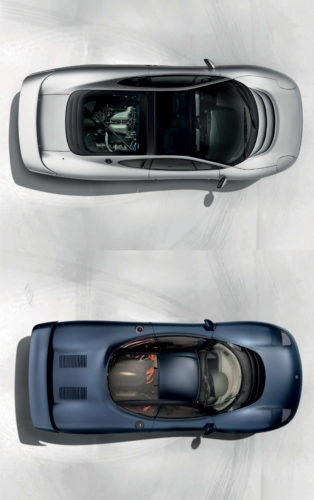
The Road Rat Issue 7
Spring 2021 Pages 168-9
The glory days of Jaguar racing in the 1950s – when it won Le Mans five times – was also being invoked by the engineering department, led by Jim Randle. Randle had secretly gathered 12 Jaguar staffers to create what was in effect a fantasy car, a supercar that could also double as a Le Mans racer. “There was a nostalgia within Jaguar for the days when race cars were road legal and driven to Le Mans,” Helfet, one of the 12, says. But it was all to be done outside office hours in almost complete secrecy: “Jim Randle was a clever bloke, and he knew that if he tried to sell this idea to the board to make it official it would never happen, because once you’ve got marketing and product planning and all these people involved, it would get overwhelmed by committees and bureaucracy and politics.” It also meant, thanks to the out-of-hours clause, that Randle, not Jaguar, legally owned the project.
The project had a distant goal: to create a car for new Group B regulations, which stipulated that race cars had to be road legal and accompanied by 200 road cars. It would be Jaguar’s answer to the challenge from Ferrari and Porsche.
Randle, however, airily claimed the project was “a bit of nonsense” to start with. “I didn’t do it with the belief that we would put this into production. I did it because we had nothing much to show at the 1988 motor show,” he said in a 2016 interview with journalists Eòin Doyle and Christopher Butt. It was one of his last; Randle died in 2019.
Egan saw the car only two days before the 1988 Birmingham Motor Show, and he brought along his trusted race partner Walkinshaw to the viewing. “They were both amazed, but Tom wasn’t that happy. Partly, I suspect, because he hadn’t done it,” Helfet says.
The other reason Walkinshaw might have looked displeased was because this was the moment when he realised he had a problem. Especially so if, as Helfet believes, this was also when Egan asked Walkinshaw and JaguarSport to build the model, suggesting that the XJ220 show car did have a production intent. Walkinshaw’s problem was that he also had plans for a supercar derived from the XJR-8 race car, which itself evolved into the XJR-9.
Meanwhile the XJ220 concept was a 24-carat-gold smash. Long, low and wide, it promised a mouth-watering specification – a 6.2-litre V12 with four valves per cylinder and ‘over 500 bhp’, rear-biased four-wheel drive, ground-effect aerodynamics, powered butterfly doors. The reveal elicited six blank-cheque deposits for the car and an extra 90,000 visitors to the NEC exhibition hall that year, according to Randle.
One visitor was designer Peter Stevens, then working out his notice at Lotus, who was invited as a guest of Walkinshaw to assess the XJ220. “He had lots of expletives,” Stevens says. “He said it was fundamentally too big, that it wasn’t a race car for the road.” Randle’s charming Sir William Lyons fantasy of driving it to Le Mans and onto the track was pointless nostalgia as far as Walkinshaw was concerned. “Things had moved on from the 1950s. Tom could see that it was much better to go the other way and produce a road-going version of a real race car,” Stevens recalls. He confirms that Walkinshaw had already planned a road version of the XJR-8 before seeing the XJ220.
A more tactful businessman might have seen that competing with his primary client was not a sound decision, but that wasn’t Walkinshaw. Once he had an idea, he wouldn’t be shifted. “He wasn’t easily deflected from what he wanted,” Stevens confirms. At the time, Stevens had practical criticism as well. He doubted the XJ220 concept’s proposed all-wheel-drive system would have fitted, and said that any production car would have to be redesigned. “Walkinshaw thought we could do better,” says Stevens, who was asked to sketch out an XJR-8 for the road. One quick drawing later, and Stevens found agreement from Walkinshaw that simply raising the race car’s ride height, adding road wheels and lifting the headlights to meet road regulations didn’t create a desirable supercar. Stevens went back, redesigned the windscreen, convinced Walkinshaw against keeping the rearwheel spats, got the green light and was given a year to create the car, taking him to 1990.
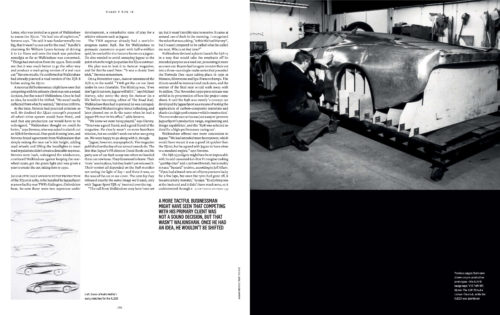
The Road Rat Issue 7
Spring 2021 Pages 170-1
JAGUAR OFFICIALLY ANNOUNCED THE PRODUCTION of the XJ220 in 1989, to be handled by JaguarSport at a new facility near TWR’s Kidlington, Oxfordshire base. So now there were two supercars under development, a remarkable state of play for a relative minnow such as Jaguar.
The TWR supercar already had a work-in-progress name: R9R. But for Walkinshaw to persuade customers to part with half-a-million quid, he needed for it to become known as a Jaguar. He also needed to avoid annoying Jaguar to the point where he might jeopardise his XJ220 contract.
His plan was to leak it to Autocar magazine, and for that he used Peter. “It was a classic Tom trick,” Stevens remembers.
On 14 November 1990, Autocar announced the XJR-15 to the world. “TWR got the car out there under its own timetable. The thinking was, ‘if we don’t get it out now, Jaguar will kill it’,” says Michael Harvey, who wrote the story for Autocar (in a life before becoming editor of The Road Rat). Walkinshaw then had to pretend he was outraged. “He phoned Michael to give him a bollocking, and later phoned me to do the same when he had a Jaguar PR man in his office,” adds Stevens. “We knew we were being played,” says Harvey. “Peter was a good friend, and a good friend of the magazine. He clearly wasn’t on some kamikaze mission, but we couldn’t work out what was going on. We were happy to go along with it, though.
“Jaguar, however, was apoplectic. The magazine published on the day of our annual awards do. The first that Jaguar’s PR director David Boole and his party saw of our R9R scoop was when we handed them our new issue. They threatened to leave. Their ‘story’ was in place, but they hadn’t yet released it. Their version all depended on the R9R moniker not seeing the light of day – and there it was, on the nose of the car on our cover. The next day they released exactly the same image we’d used, only with ‘Jaguar Sport XJR-15’, inserted over the top.
“The call from Walkinshaw may have been set up, but it wasn’t terribly nice to receive. It came at around two o’clock in the morning. I recognised the voice that was asking, ‘Is this Michael Harvey?’, but I wasn’t prepared to be called what he called me next. Who is at that time?”
Walkinshaw devised a plan to launch the XJR-15 in a way that would take the emphasis off its intended purpose as a road car, presenting it more as a race car. Buyers had to agree to enter their car into a three-race single-make series that preceded the Formula One races taking place in 1991 at Monaco, Silverstone and Spa-Francorchamps. The drivers would be international track stars, and the winner of the final race would walk away with $1 million. The November 1990 press release was artful in its presentation of how the project came about. It said the R9R was merely ‘a concept car developed by JaguarSport as a means of testing the application of carbon-composite materials and plastics in a high-performance vehicle construction’. The one-make race series was just a way to ‘promote JaguarSport’s production range, engineering and design capabilities’, and the ‘R9R was selected as ideal for a high-performance racing car’.
Walkinshaw offered one more concession to Jaguar. “We had intended more horsepower, which would have meant it was a good bit quicker than the XJ220, but he agreed with Jaguar to have close to a standard engine,” says Stevens. The XJR-15 pedigree might have been impeccable with its mid-mounted 6.0-litre V12 engine making “450bhp-plus” and a carbon-fibre tub, but in reality it was a “bastard” to drive, according to Jeff Allam. “If you had a brand-new set of tyres you were lucky for a few laps, but once the tyres had gone off, it became a hairy monster,” he says. “Everything was at the back end and it didn’t have much aero, so it understeered through a corner, pushed by the back, then started to slide when you came out.” The $1 million was netted by German driver Armin Hahne, who’d persuaded the owner of a German DIY chain to buy a car.
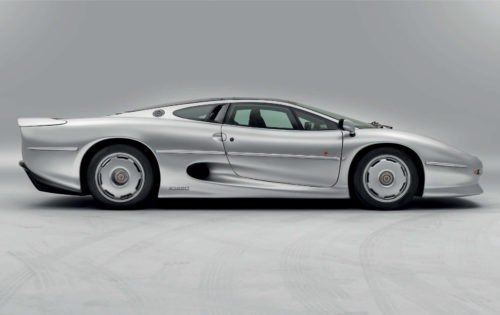
The Road Rat Issue 7
Spring 2021 Pages 172-3
The XJ220, meanwhile, was undergoing a reality check as it headed to production. Out went the fantasy four-wheel drive and V12 engine, to be replaced by a turbocharged V6, the design of which Walkinshaw had bought from BL after it stopped rallying the Metro 6R4 – those origins to be continuously played down by Jaguar. “It wasn’t a bad choice. It was an extremely capable engine, but it didn’t have the gravitas, literally and figuratively, of the V12,” says Keith Helfet, who moved over to JaguarSport to help productionise the design.
The reasons for swapping it in place of the V12 were pure Walkinshaw, ever mindful of the benefits to him, particularly financial, in the present and the future. The lower-budget V6 was also more compact, lighter and had a proven race pedigree. Out went the scissor doors for similar pragmatic reasons. Too complicated, too heavy, too costly.
Helfet shortened the wheelbase and wanted to chop the nose back, but Walkinshaw forbade it. That would have taken too long, he was told.
Jim Randle was ostensibly overseeing Walkinshaw’s progress. “Anyone who believes that to be the truth would be very easily conned, I think, because Walkinshaw was off doing his own thing all the time,” Randle later said.
The fact the production car came with a V6 and not a V12 was seized on by some depositors who were trying to wriggle out of their 1990 contract, but the brochure produced that same year had been very clear. They were buying a car with a ‘race-developed Jaguar twin-turbo 3.5-litre V6’ making 500 bhp (later 542 bhp). The car was now 4,860 mm long instead of the 5,140 mm concept, and the weight had dropped to 1,350 kg from 1,560 kg. Jaguar promised a maximum speed of over 200 mph, and later clocked 217 mph at the Nardò testing facility in Italy, just shy of the 220 mph the car was named after.
Interest in the production XJ220 had at first been huge. Jaguar received 1,450 applications to buy 350 cars. You couldn’t post your £50,000 cheque; you had to queue up at Walkinshaw’s unfinished production facility in Bloxham. London-based Jaguar dealer Michael Quinn, also Sir William Lyons’s grandson, remembers sending his foreman to secure a car for a customer. “It was chaotic. He arrived in the middle of Oxfordshire to queue outside what amounted to a Portakabin in a field. There were Rolls-Royces and Range Rovers parked on the verges.” Despite the foreman securing a prized place near the front of the queue, Quinn’s customer never heard back from Jaguar.
Contemporary car magazine road tests were divided about the XJ220. Autocar was full of praise for its performance and the excellent throttle control provided by the V6. ‘Right now, the XJ220 gives us a standard by which all other fast cars can be compared,’ it concluded. Reviewers generally loved the ride, driving position (a big plus when Italian supercars of the time were making contortionists of their drivers) and build quality. But in a comparison test with the Bugatti EB110 in 1994, Car magazine was pretty scathing about its handling – and traits shared with the XJR-15. ‘If there’s a more evil device on our roads, I wouldn’t like to find it, for the XJ220 suffers from immense initial understeer followed by violent and snappy, pendulous oversteer,’ its road tester wrote.
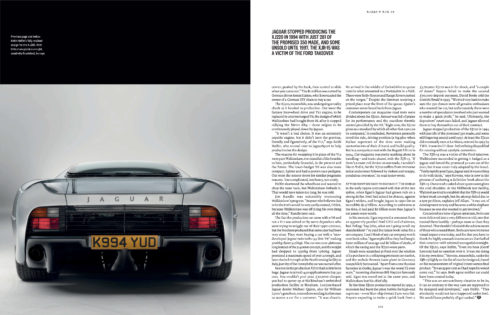
The Road Rat Issue 7
Spring 2021 Pages 174-5
AT THIS POINT WE NEED TO ZOOM OUT. THE WORLD in the early 1990s contrasted with that of the late 1980s, when Egan’s Jaguar had grown rich on a strong dollar. Ford had seized its chance, against Egan’s wishes, and bought Jaguar in 1990 for an incredible $2.5 billion. According to estimates at the time, it had paid $2 billion more than Jaguar’s net assets were worth.
In his memoir, Egan reported a comment from an apparently puzzled Ford CEO and chairman, Red Poling: ‘Say John, what am I going to tell my shareholders? I’ve paid five times book value for a car company. I can’t think of any car company worth even book value.’ Egan replied that they had bought $500 million of sausage and $2 billion of sizzle, of which the racing and the XJ220 were parts. Heads were scratched at Ford over the wisdom of its purchase in a collapsing premium car market, and the archaic Browns Lane plant in Coventry was publicly bemoaned. “Apart from some Russian factories in Gorky, Jaguar’s was the worst I’d ever seen,” incoming chairman Bill Hayden famously said. Egan was eased out in the same year, and Walkinshaw lost his chief ally.
By the time XJ220 production started in 1992, a recession had burst the price bubble for high-end supercars – even blue-chip Ferrari F40s were hit. Anyone expecting to make a quick buck from a £470,000 XJ220 was in for shock, and “a couple of dozen” buyers failed to make the second £50,000 deposit payment, David Boole told the Scottish Herald in 1993. “We tried very hard to make sure the 350 chosen were all genuine enthusiasts who wanted the car, but unfortunately there were a number of speculators involved who just wanted to make a quick profit,” he said. Ultimately, the depositors’ court case failed, and Jaguar allowed them to buy themselves out of their contract.
Jaguar stopped production of the XJ220 in 1994 with just 281 of the promised 350 made, and some still lingering unsold until 1997. At least the XJ220 did eventually race at Le Mans, entered in 1993 by TWR. It won its GT class – before being disqualified for running without catalytic converters.
The XJR-15 was a victim of the Ford takeover. Walkinshaw succeeded in getting it badged as a Jaguar and forced the promised 50 cars out of the door, but it was never truly adopted by the brand. “Fairly rapidly post Egan, Jaguar said it was nothing to do with them,” says Stevens, who is now in the process of authoring a definitive book about the XJR-15. Owners who asked about spares were given the cold shoulder. At the Millbrook test facility, Walkinshaw tried to establish that the XJR-15 would in fact break 200 mph, but the attempt failed due to a tyre problem, explains Jeff Allam. “It ran out of development money and became a white elephant because no one else wanted to get involved.”
Conceived in a time of great optimism, both cars were delivered into a very different world, one that treated them harshly – perhaps more so than they deserved. That shouldn’t diminish the achievements of those who created them. Both cars have immense visual impact even today, and for that you have to thank the highly unusual circumstances that fuelled their creation – with minimal managerial oversight. Of the XJ220, says Helfet, “Even my boss [Geoff Lawson] had no sanction over it. It was me doing it in my own time.” Stevens, meanwhile, ranks the
XJR-15 highly on the list of cars he designed, based on his measurement of original intent versus final product. “It was 95 per cent as I had hoped it would come out,” he says. Both agree neither car could have been created today.
“This was an extraordinary situation to be in; it ran so contrary to the way cars are supposed to be designed and developed,” says Helfet. “This absolutely would not have happened under Ford. We would have probably all got sacked.”
Words: Nick Gibbs
Photography: Ashley Border